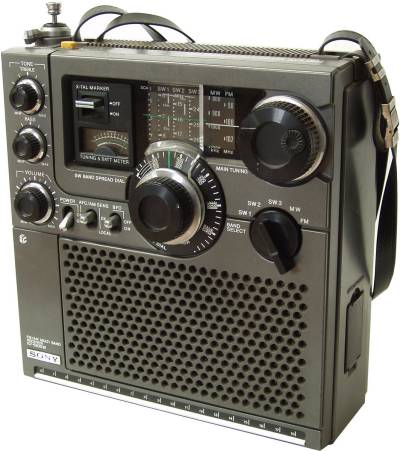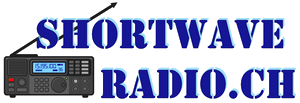Inhaltsverzeichnis
Sony ICF-5900W
Manufactured by Sony Corp., Tokyo.
The ICF-5900W has a similar format like the Captain 55 or 77, but the cabinet houses a double conversion superhet with a completely different operating scheme.

Technical data
- Frequency range: FM broadcast band, MW, 3 x SW (3.9-10 / 11.7-20 / 20-28 MHz)
- Frequency display: analogue dial, crystal calibrator, interpolation dial 10 kHz
- Frequency memory: none
Power supply
- Mains operation: 110, 220 V with AC-456C mains adapter
Dimensions
- 220 x 230 x 100 mm, weight 2.2 kg
Accessories
Operation
The ICF-5900W has a similar appearance like the radios in Sony's Captain series, but with 22 x 23 x 10 cm and a weight of 2.2 kg, it is slightly bigger.
The receiver is powered by three 1.5V UM-1 batteries or alternatively by an AC-456C mains adapter.
The controls on the front panel of this set are arranged in a somewhat unconventional way: There is a film dial in the middle of the front panel, similar to the one in the Captain 77, but the set has three shortwave ranges, and the 0.25 MHz marks on the dial deserve some attention, as these calibration marks are important for the operation.
The main tuning knob is located at the right of the film dial, the large rotary knob below it is the fine tuning knob with the +/- 125 kHz - interpolation dial, the band range switch is located to the right of it.
At the left of the frequency dial is the switch for the 250 kHz crystal calibrator and below that is the S-meter, which also serves as battery level indicator.
On the left side of the front panel are the separate bass and treble controls, and the volume control, right next to them the main switch, the DX/LOCAL sensitivity switch and the BFO switch.
The retractable telescopic antenna on the upper front of the receiver pops out at the push of a button and must be fully extended for reception; alternatively, a long-wire antenna and external earth can be connected to the screw terminals on the rear.
The receiver is switched on with the POWER switch and the volume control is turned up until a hiss is audible. The sensitivity control should be set to DX and the BFO switched off. Use the band switch to set the range SW1 for reception in the 49m band - you can now hunt for transmitters with the main tuning knob.
To find a station on a known frequency, use the main tuning knob to find the nearest calibration mark and then use the interpolation dial to set the difference to the calibration mark. To receive Deutsche Welle on 6075 kHz as an example, activate the crystal calibrator by pressing the crystal marker switch and look for the 6.0 MHz mark, the main tuning is then tuned to zero beat (i.e. disappearance of the low-frequency whistle), the interpolation dial (BAND SPREAD DIAL) must be set to 0 in the centre position. Now tune the interpolation dial to the right to find the position between the 70 and 80 kHz marks: the Deutsche Welle should be heard from the speaker now. For frequencies lying up to 125 kHz below the 250 kHz calibration marks, the fine tuning dial must be turned to the left and the value subtracted from the calibration mark frequency. 6220 kHz are tuned by finding the calibration mark for 6.25 MHz and tuning to - 30 kHz with the interpolation dial. For the frequency 15565 kHz, the calibration mark 15.5 MHz in band two must be found and the fine tuning dial set to + 65 kHz.
 The tuning procedure of the ICF-5900W is somewhat awkward, but you should keep in mind, that the receiver was one of the few sets with a usable frequency dial accuracy in the mid-seventies, along with the Barlow Wadley XCR-30 and perhaps Panasonic's RF-2200.
The tuning procedure of the ICF-5900W is somewhat awkward, but you should keep in mind, that the receiver was one of the few sets with a usable frequency dial accuracy in the mid-seventies, along with the Barlow Wadley XCR-30 and perhaps Panasonic's RF-2200.
Thus it retains its place as a collector's item and documents a milestone in the development of shortwave travel receivers, even if with the appearance of the ICF-7600D, the sets with PLL synthesis are much easier to handle.
Technical principle
Double conversion, crystal calibrator and interpolation dial.
Components
The set is equipped with semiconductors.




